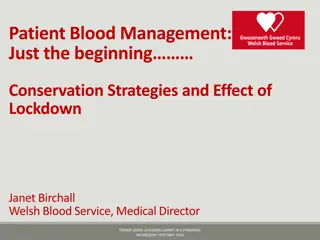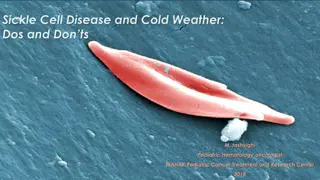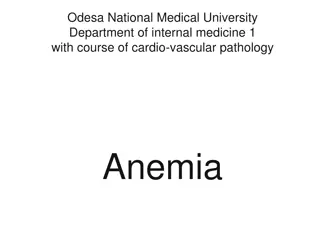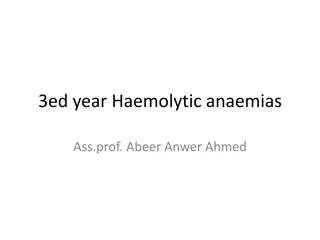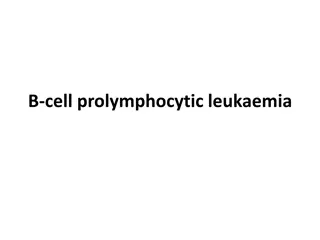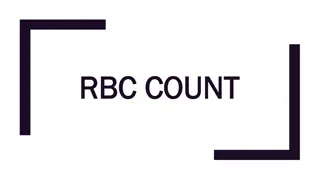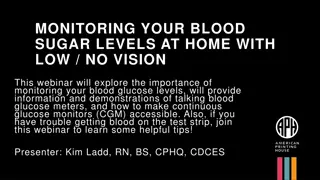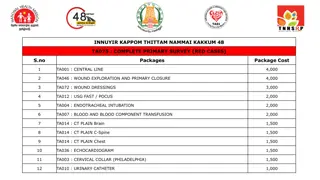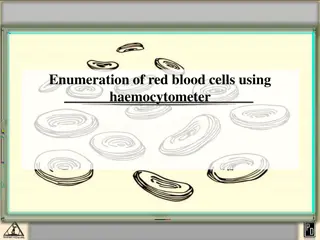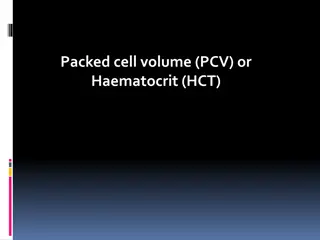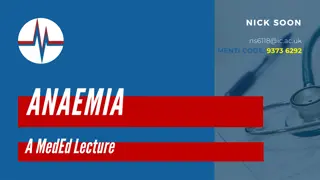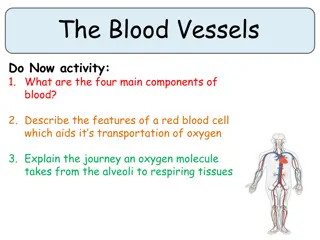Challenges in Managing O- Red Cell Component Blood Supply
Addressing the challenges of managing O- red cell component blood supply involves considerations such as compatibility rules, absolute and relative indications, EBA benchmark comparisons, data monitoring, case studies, D variant specifications, and recommendations for transfusions. The supply side collection and distribution of O- blood, along with EBA benchmarking comparisons, play crucial roles in ensuring efficient blood management. Emphasizing the importance of ABO blood group compatibility, the content also delves into specific cases, such as patients with anti-D antibodies, females of child-bearing potential, and emergency transfusions. The discussion covers the activation of O- donors, donation indices, donor resistance markers, and conservation efforts to meet the demand for O- blood components.
Download Presentation

Please find below an Image/Link to download the presentation.
The content on the website is provided AS IS for your information and personal use only. It may not be sold, licensed, or shared on other websites without obtaining consent from the author. Download presentation by click this link. If you encounter any issues during the download, it is possible that the publisher has removed the file from their server.
E N D
Presentation Transcript
The challenges of managing O- red cell component blood supply Users meeting 18 November 2020
Content Compatibility rules Absolute indications for O- Relative indications for O- Supply side collection and distribution EBA benchmark comparisons Internal IBTS data monitoring Case study (1) Case study (2)
Content D variant consider as D- Neonatal specification standing order Case study (3) OPTIMUS study Conclusions Recommendations and solutions
Compatibility rules Transfusions should be ABO blood group identical or at least ABO blood group compatible O may be given to O and O may be given to non O D- should be given to D- O D- is described as universal donor
ABO test and compatibility rules O - - - + + - A + - + - + - B - + + + - - AB + + + - - - Anti-A Anti-B Anti-AB A B O
Absolute indication for O- Patient with antibody anti-D Female gender O- patient who is potentially child bearing
Relative indications for O- Emergency transfusion no blood group Combinations of red cell antigens typed O- inventory Neonatal specification red cell components Substitution (cDe) haplotype sickle cell anaemia patients
Supply side collection and distribution Element Active O- donors (at least one completed donation since 01 October 2018) Donation index Activation of donors measures Comment 11,531 1.86 SMS special invitation adjacent clinic sub panels 56% reliability 2 or less Reliability scores ( five invitations, five completed donation = 5) Over bleeding risk 25 % female gender presentations low/absent ferritin Complaints, drop off in reliability 5.1% Soft markers of donor resistance First time completed donations % O- conservation notifications
Distribution arrangements 45 HSE hospital blood banks, 9 independent sector Controlled temperature storage and shipment and daily deliveries and twice daily deliveries Re routing O- near time expiry (10-15%) O- component attrition 0.5% No agreed minimum tariff stock holding and sharing of information in structured electronic report
O- distribution hospital network selected examples (2018) Hospital O- (%) Comment St Vincent s 09.9 Exemplar best practice NMH 40.1 Reflects tertiary referral centre obstetrics and high risk pregnancies Reflects sickle cell anaemia cohort CHI Crumlin 29.1 22.9 Reflects sickle cell anaemia cohort and default to O- for ABO mis-matched stem cell transplants St James
Collection performance 29 October 2020 Data in this report is as of: 30/10/2020 06:37 WB Collections Yesterday (W,X,Y,Z phlebotomies) O+ O- A+ A- B+ B- AB+/- Unk Total Dublin 200 93 119 31 31 27 10 22 533 Cork 111 19 49 9 14 4 7 12 225 Total 311 112 168 40 45 31 17 34 758 Percentage 41.0% 14.8% 22.2% 5.3% 5.9% 4.1% 2.2% 4.5% 1 Day (Units) 161 54 88 21 32 10 7 372 Day's Supply 1.9 2.1 1.9 1.9 1.4 3.1 2.5 2.0
Stock report 30 October 2020 Total Banked RBCs O+ O- A+ A- B+ B- AB+ AB- Total Dublin 539 198 210 108 144 29 62 21 1311 Cork 201 72 63 36 47 6 15 4 444 Total 740 270 273 144 191 35 77 25 1755
Stock projections tool Est Stock at 12/10/20 882 278 423 146 335 58 104 2226 -166 92.5% -114 -8 -76 6 19 -5 12 wc 12/10/20 12.9% Deferral O+ O- A+ A- B+ B- AB+ AB- Total Stock at 12/10/20 768 270 347 152 354 53 116 2060 Days Stock 4.8 5.0 4.0 6.9 11.4 5.2 16.6 Est Banked 946 332 492 133 185 60 37 13 2199 -136 Est Issues 1005 318 581 162 171 62 20 16 2335 Est Stock at 19/10/20 710 284 257 124 368 51 129 1924 1 days stock 161 54 87 22 31 10 7 Est Days Stock at 19/10/20 4.4 5.2 3.0 5.6 11.8 5.0 18.5
Case study (1) Level 3 hospital (1,500 red cell components) Normal stock holding O- =9 (+ adult emergency, +1 neonatal large volume transfusion ) Eight months of results 196 received, 44 re routed and 69 neonatal specification 152 O- transfused (14.63%) 84% transfused to O- and emergency group not known 16% transfused to O+ near time expiry
Case study(2) Factor Transfused O- eight months Transfused O- twelve months Issuable stock index Stock holding Comment 152 218 0.6 15 days
Case study (1) control measures Blood ordering tariffs surgery and gynaecology Placenta praevia special consideration Emergency transfusion switch to ABO group specific Medical and nursing education programmes patient blood management Active monitoring and reporting of red cell component usage and attrition
Case study (1) control measures Retrospective audit massive haemorrhage Formal review release un cross matched O- Note total red cell components re routed =163 (15.7%) Note O- red cell components rerouted= 44 Note neonatal specification = 66 O- (35.2%) and none disposed for this clinical indication (large volume transfusion neonate)
Case study (2) Clinical category Number of red cell components 940 Percentage O- to O- 35.0 Sickle cell anaemia patients Allogeneic stem cell transplants 979 37.0 256 10.0 O- to O+ Emergency transfusion not grouped Patient with antibody anti- D Attrition 214 169 08.0 06.0 056 02.0 046 01.7
Adult sickle cell anaemia service red cell component projected requirements SJH sickle service projected demand for red cell components Number of red cell components 2019 1991 (actual) 2020 3160 2021 3615 2022 4057 2023 4616
Case study (3) Calendar year SCD patients on transfusion programmes SCD patients on exchange programmes Number of red cell components transfused (per month) 401 418 507 Requested (cDe) haplotype (per month) 2018 2019 2020 86 93 94 15 17 20 146 192 182 Annual increase 15-21% recurring Note 41% molecular genotype D variant (transfusion protocol O-)
Irish sickle cell anaemia cohort blood group frequencies Red cell antigen Percentage Irish blood donors Percentage African ancestry recipients Rh D C E c e K Fya Fyb Jka Jkb S s 85 68 29 80 98 09 66 83 77 74 51 89 92 27 20 96 98 02 10 23 92 49 31 93 Fy Jk MNS
Haemoglobinopathy Schedule for St.James & Our Ladys Childrens Hospital Crumlin (Ro and rr orders) October Month : Orders in black = SJH Orders in green = Crumlin Wednesday Monday Tuesday Thursday 1st Friday 2nd 14 O Ro 7 O Ro 7 O rr Monday 5th Tuesday 6th Wednesday 7th Thursday 8th Friday 9th 1 A Ro 3 ORo 4 ORo 12 O Ro 8 ORo 11 A rr 8 B Ro 10 B rr 11 A Ro Wednesday 14th 6 O rr 18 O Ro 13 B Ro Monday 12th Tuesday 13th Thursday 15th Friday 16th 2 O Ro 1 B Ro 14 A Ro 7 B Ro 7 O rr 7 O rr S-Fya- 12 B rr 11 B Ro 8 A Ro 7 B Ro 8 O Ro 13 B Ro Monday 19th Tuesday 20th Wednesday 21st Thursday 22nd Friday 23rd 8 A Ro 2 O rr 2 B rr 9 O rr 5 ORo 10 B rr 6 A rr 7 ORo Monday 26th Tuesday 27th Wednesday 28th Thursday 29th Friday 30th 2 O Ro 9 ORo 7 O rr 7 O Ro 10 B rr 11 A rr 11 A Ro 9 A Ro
Ro rr 228 117 345 66.1% 33.9% % in population
O Ro A Ro B Ro O rr A rr B rr AB Ro Total/week 28 21 7 105 45 12 21 6 11 10 97 10 22 39 14 12 49 12 8 11 6 12 66 18 20 7 11 10 O Ro A Ro B Ro O rr A rr B rr AB Ro Total/Month 345 106 62 60 45 28 44 0 30.7% 18.0% 17.4% 26 13.0% 8.1% 12.8% 100.0% 47 9 8 5 2 2 Group O 43.8% Group A 26.1% Group B 30.1% 104 100.0% 151 8% 90 5% 345 2%
Neonatal specification standing order IBTS advice and guidance is all hospital blood banks (19) supporting maternity units should order routinely 2 x O- neonatal specification less than five days from collection (means twice a week) Orders not filled 30% Prioritisation protocol factors number of birth deliveries and distance from supplying blood centre
Case study (4) emergency transfusion not grouped (n= 257) ABO group O- O+ ABO group specific Percentage 07 17 76 Policy is obtain ABO group within 15 minutes of presentation in ED or clinical area D group determined first valid sample issue D group specific ABO group determined second valid sample Issue ABO group specific
Hospital locations where O D(-) transfused BEST collaborative study Obstetric ward Hospital ward Intensive care unit Outpatient clinic Operating room Emergency department Other 9646 (44%) 3117 (14%) 4524 (20%)
Case study (4) decision making Male gender patient aged 44 recidivist Multiple trauma including head injury and neurosurgery intervention O- transfused (4) O+ transfused (10) Presented to another hospital ten days later major haemorrhage acute severe gastrointestinal bleed only 3 x O- in stock
O- product transfusion, inventory management and utilization during shortage: the OPTIMUS study Nancy M. Dunbar, Mark H. Yazer Transfusion 2018;58;1348-1355
OPTIMUS Study Study design and methods Retrospective cross-sectional observational study use of O negative red cell components 26 sites global network, 475,830 units 42,960 O negative (9.0%) Modelling exercise estimating the impact of O positive substitution for O negative recipients based on age and ward location
OPTIMUS Study Impact of RhD switching modelled Principle is to conserve O negative for female gender potentially child bearing and allo-immunised recipients Patient Group All patients >50 years All patients >80 years All patients >50 years critical care % Reduction 44.5 9.9 8.7
Conclusion The space for inventory management is narrowing and the projected increase in demand is not sustainable
Solutions page Some immediate relief obtained if neonatal specification O- standing order arrangement reduced/stood down Recruitment (and retention) of African ancestry donors (cDe) haplotype to minimise O- substitution Best practice inventory management in hospital blood banks (stock holding, remote location fridges, emergency transfusion not grouped, D switching




















